List of World Heritage Sites in Italy

The United Nations Educational, Scientific and Cultural Organization (UNESCO) World Heritage Sites are places of importance to cultural or natural heritage as described in the UNESCO World Heritage Convention, established in 1972.[1] Cultural heritage consists of monuments (such as architectural works, monumental sculptures, or inscriptions), groups of buildings, and sites (including archaeological sites). Natural features (consisting of physical and biological formations), geological and physiographical formations (including habitats of threatened species of animals and plants), and natural sites which are important from the point of view of science, conservation or natural beauty, are defined as natural heritage.[2] Italy ratified the convention on June 23, 1978.[3]
As of 2021, Italy has a total of 58 inscribed properties, making it the state party with the most World Heritage Sites just above China (56).[4][3] The first site in Italy, the Rock Drawings in Valcamonica, was listed at the 3rd Session of the World Heritage Committee, held in Cairo and Luxor, Egypt, in 1979.[5] A total of 25 Italian sites were added during the 1990s, with 10 sites added at the 21st session held in Naples in 1997. Italy has served as a member of the World Heritage Committee four times, specifically, 1978–1985 (8 years), 1987–1993 (7 years), 1993–1999 (7 years), and 1999–2001 (3 years).[6]
Out of Italy's 58 heritage sites, 53 are cultural and 5 are natural.[3] Seven sites are transnational. Historic Centre of Rome is shared with the Vatican; Monte San Giorgio and Rhaetian Railway in the Albula / Bernina Landscapes with Switzerland; Venetian Works of Defence with Croatia and Montenegro; Prehistoric pile dwellings around the Alps with 5 other countries; The Great Spa Towns of Europe with 6 other countries; and the Ancient and Primeval Beech Forests of the Carpathians and Other Regions of Europe are shared with 17 other countries. In addition, Italy has 31 sites on the tentative list.[3]
World Heritage Sites[]
UNESCO lists sites under ten criteria; each entry must meet at least one of the criteria. Criteria i through vi are cultural, whereas vii through x are natural.[7]
| Site | Image | Location (province) | Year listed | UNESCO data | Description |
|---|---|---|---|---|---|
| Rock Drawings in Valcamonica | 
|
Brescia | 1979 | 94; iii, vi (cultural) | Valcamonica is home to one of the largest collections of petroglyphs in the world. Over 300,000 carvings have been created in a valley over a period of 8,000 years from the Epipalaeolithic to the Middle Ages. They depict scenes from agriculture, navigation, war, and magic.[8][9] |
| Historic Centre of Rome, the Properties of the Holy See in that City Enjoying Extraterritorial Rights and San Paolo Fuori le Mura* | 
|
Metropolitan City of Rome Capital | 1980 | 91ter; i, ii, iii, iv, vi (cultural) | The city of Rome was the centre of the Roman Empire and later of the Christian world. It is home to a large number of major monuments of antiquity, including the Colosseum (pictured), the Pantheon, and the Roman Forum, as well as buildings from the Renaissance and Baroque periods. Originally listed as the "Historic Centre of Rome", the site was expanded in 1990 and renamed to the current name. Another boundary modification took place in 2015. The site is shared with the Holy See.[10] |
| Church and Dominican Convent of Santa Maria delle Grazie with "The Last Supper" by Leonardo da Vinci | 
|
Metropolitan City of Milan | 1980 | 93; i, ii (cultural) | The complex of the Dominican Convent in Milan was constructed in the second half of the 15th century, it is partially attributed to Bramante. The northern wall of the reflectory of the convent features the mural of The Last Supper by Leonardo da Vinci, a masterpiece of High Renaissance art.[11] |
| Historic Centre of Florence | 
|
Metropolitan City of Florence | 1982 | 174ter; i, ii, iii, iv, vi (cultural) | The city of Florence is the symbol of the Renaissance and was an important centre of Renaissance humanism. It has had a profound influence on architecture and arts of Italy and Europe, being associated with artists such as Giotto, Brunelleschi, Botticelli, and Michelangelo. Monuments in the city include the Florence Cathedral, Basilica of Santa Croce, the Uffizi, and the Palazzo Pitti. Minor boundary modifications of the site took place in 2015 and 2021. Piazza della Signoria is pictured.[12] |
| Piazza del Duomo, Pisa | 
|
Pisa | 1987 | 395bis; i, ii, iv, vi (cultural) | Piazza dei Miracoli is one of the finest medieval architectural complexes in the world and comprises four masterpieces from the 11th to 14th century: the cathedral, the baptistry, the cemetery, and the leaning tower. The Pisan Romanesque architecture style developed here was influential in other Tuscan cities. The complex is also associated with Galileo Galilei who was conducting his experiments tehre. A minor boundary modification took place in 2007.[13][14] |
| Historic Centre of San Gimignano | 
|
Siena | 1990 | 550; i, iii, iv (cultural) | The town of San Gimignano was an important stop for pilgrims on the Via Francigena in the Middle Ages. The city preserves its Medieval character, with its most prominent feature being the high towers, built between the 11th and the 13th century the noble families and upper middle-class merchants. Fourteen of these towers have survived to present day. Churches and palaces of the town are home to several masterpieces of artists from the 14th and 15th centuries.[15] |
| City of Vicenza and the Palladian Villas of the Veneto | 
|
Padua, Rovigo, Treviso, Metropolitan City of Venice, Verona, Vicenza | 1994 | 712; i, ii (cultural) | In the 16th century, while under the Republic of Venice, several villas were built in the city of Vicenza and the surrounding Veneto region by the architect Andrea Palladio (1508–80). His designs had a profound influence on the architecture and inspired the Palladian style. Originally listed in 1994 as "Vicenza, City of Palladio", the site was expanded in 1996 to include several villas in the region. Villa Chiericati is pictured.[16][17] |
| Historic Centre of Siena | 
|
Siena | 1995 | 717; i, ii, iv (cultural) | The city of Siena has preserved its Medieval Gothic character from the 12th to 15th century. The city is built around the Piazza del Campo. Several important Renaissance painters worked and were born in Siena, including Duccio, Ambrogio Lorenzetti, and Simone Martini. The Siena Cathedral is pictured.[18] |
| Historic Centre of Naples | 
|
Metropolitan City of Naples | 1995 | 726bis; ii, iv (cultural) | Naples, Founded in 470 BCE by Greek colonists, was one of the most important cities of Magna Grecia, of the Roman Republic, and the capital of the Kingdom of Naples under several royal houses. It was highly influential on European arts and architecture. Some of the important monuments include the Church of Santa Chiara from the 14th century, the Castel Nuovo from the 13th century (pictured), and the Royal Palace from the 17th century. A minor boundary modification took place in 2011.[19] |
| Crespi d'Adda | 
|
Bergamo | 1995 | 730; iv, v (cultural) | Crespi d'Adda is a well preserved and partially in use company town built in the 19th and 20th centuries for the workforce of a textile manufacturer Cristoforo Crespi. The town includes both residential buildings and common public services such as a clinic, a school, theatre or sports centre.[20] |
| Ferrara, City of the Renaissance, and its Po Delta | 
|
Ferrara | 1995 | 733bis; ii, iii, iv, v, vi (cultural) | Ferrara, the seat of the House of Este, was an intellectual and artistic centre during the Italian Renaissance of the 15th and 16th century. It attracted artists to decorate several mansions and palaces (Este Castle pictured), while the architectural school influenced the styles in Italy and Europe. Originally listed as "Ferrara, city of the Renaissance", the site was expanded in 1999 to include the cultural landscape of the Po Delta.[21][22] |
| Castel del Monte | 
|
Barletta-Andria-Trani | 1996 | 398rev; i, ii, iii (cultural) | The octogonal castle was built by Emperor Frederick II in the 13th century. It blends northern European Cistercian Gothic, Muslim architecture, and elements from Classical antiquity in a perfectly symmetrical design.[23] |
| Early Christian Monuments of Ravenna | 
|
Ravenna | 1996 | 788; i, ii, iii, iv (cultural) | This site comprises eight monuments in the city of Ravenna, which was the seat of the Roman Empire in the 5th century. The churches and mausolea are decorated with mosaics of outstanding artistic quality that mix motives from Western and Byzantine arts. The Basilica of San Vitale is pictured.[24] |
| Historic Centre of the City of Pienza | 
|
Siena | 1996 | 789; i, ii, iv (cultural) | In 1459, Pope Pius II decided to transform his hometown of Pienza according to Renaissance Humanist ideas of urban design. The project was supervised by the architect Bernardo Rossellino who built new squares, churches, and palaces. Pienza was later a model for urban development in other Italian and European cities.[25] |
| 18th-Century Royal Palace at Caserta with the Park, the Aqueduct of Vanvitelli, and the San Leucio Complex | 
|
Caserta and Benevento | 1997 | 549rev; i, ii, iii, iv (cultural) | Large scale palace complex was comissioned by the Bourbon King of Naples Charles III in the mid 18th century. It was designed by the architect Luigi Vanvitelli and inspired by palaces in Versaiiles and Madrid. Inspired by the ideas of the Enlightenment, the complex is well integrated into the landscape. The site includes an aqueduct and the industrial complex of San Leucio where silk was produced.[26] |
| Residences of the Royal House of Savoy | 
|
Metropolitan City of Turin, Cuneo | 1997 | 823bis; i, ii, iv, v (cultural) | This site comprises 22 palaces and villas constructed to demonstrate the power of the ruling monarchy following the move of the capital of House of Savoy to Turin by Emmanuel Philibert in 1562. The buildings, mostly in Baroque style, are representative of 17th and 18th century European monumental architecture. A minor boundary modification took place in 2010. The Palazzina di caccia of Stupinigi is pictured.[27][28] |
| Botanical Garden (Orto Botanico), Padua | 
|
Padua | 1997 | 824; ii, iii (cultural) | Padua's botanical garden was founded in 1545 as the world's first university botanical garden. It has been a centre of scientific research for centuries, as well as a template for other gardens. It was renovated in the 18th century but still retains its original layout.[29] |
| Portovenere, Cinque Terre, and the Islands (Palmaria, Tino and Tinetto) | 
|
La Spezia | 1997 | 826bis; ii, iv, v (cultural) | The cultural landscape along the Ligurian coast has been shaped by humans over the past millennium. There are several scenic small towns built among the steep rugged terrain, and the land has been converted to terraces. There are also three islands off coast with remains of early monastic buildings. A minor boundary modification took place in 2021. A church in Porto Venere is pictured.[30] |
| Cathedral, Torre Civica and Piazza Grande, Modena | 
|
Modena | 1997 | 827; i, ii, iii, iv (cultural) | The 12th-century complex comprising the cathedral, the tower, and the square is an excellent example of early Romanesque art, with strong influence on the development of the style. The cathedral was designed by the architect Lanfranco and decorated by the sculptor Wiligelmo.[31] |
| Amalfi Coast (Costiera Amalfitana) | 
|
Salerno | 1997 | 830; ii, iv, v (cultural) | The Mediterranean cultural landscape of the Amalfi Coast was shaped prominently during the time of the Medieval Duchy of Amalfi (from the 9th to 11th century) in a mixture of Western and Byzantine influences. The coast includes towns, such as Amalfi and Ravello, as well as vineyards, orchards, and pastures, at the point where the mountains are touching the sea.[32] |
| Archaeological Area of Agrigento | 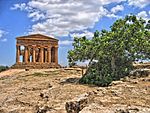
|
Agrigento | 1997 | 831; i, ii, iii, iv (cultural) | Agrigento, a Greek colony founded in the 6th century BCE, developed into one of the major cities of Magna Graecia and of the Mediterranean. Several doric temples have been preserved, and they represent one of the most notable sites of Greek art and culture.[33] |
| Archaeological Areas of Pompei, Herculaneum and Torre Annunziata | 
|
Metropolitan City of Naples | 1997 | 829; iii, iv, v (cultural) | This site comprises three sites that were buried under volcanic ash during the eruption of Mount Vesuvius in 79 CE. The towns of Pompeii and Herculaneum are two Roman towns that have been preserved completely and provide insight into the life in the 1st century CE while the two villas at Torre Annunziata have well preserved wall paintings. The sites have been progressively excavated since the mid-18th century.[34] |
| Su Nuraxi di Barumini | 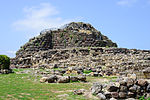
|
South Sardinia | 1997 | 833; i, iii, iv (cultural) | Su Nuraxi is the finest and the most complete example of nuraghe, a defensive megalithic structure of the Bronze Age Nuragic civilization of the 2nd millennium BCE. Unique to Sardinia, nuraghi are circular defensive towers in the form of truncated cones with internal chambers. The one at Su Nuraxi was originally over 18.5 metres (61 ft) high. The site was abandoned in the 6th century BCE and most nuraghi went out of use after Roman colonization in the 2nd century BCE.[35] |
| Archaeological Area and the Patriarchal Basilica of Aquileia | 
|
Udine | 1998 | 825ter; iii, iv, vi (cultural) | Aquileia was one of the wealthiest cities of the Early Roman Empire. In 452, it was sacked by the Huns under Attila; most of the ancient city now remains preserved and unexcavated. The Patriarchal Basilica, with its mosaic floors, dates to the 4th century. It was rebuild between the 11th and 14th centuries. It played a major role in spreading of Christianity in the early Middle Ages. Minor boundary modifications took place in 2017 and 2018.[36] |
| Historic Centre of Urbino | 
|
Pesaro and Urbino | 1998 | 828; ii, iv (cultural) | In the 15th century, Urbino flourished under the leadership of Federico da Montefeltro, a humanist who attracted some of the most prominent scientists and artists to the city. The city's Renaissance architecture has been largely preserved as Urbino entered cultural and economic stangation from the 16th century onwards.[37] |
| Cilento and Vallo di Diano National Park with the Archeological sites of Paestum and Velia, and the Certosa di Padula | 
|
Salerno | 1998 | 842; iii, iv (cultural) | The cultural landscape was shaped by different societies through centuries, including Etruscans, Lucanians, Greek colonists, and later Romans. The site includes the remains of Paestum and Velia, two major towns from classical times. The Carthusian monastery Certosa di Padula dates to 1306, although most of the present buildings are from the 17th and 18th centuries in the Baroque style.[38] |
| City of Verona | 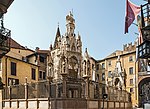
|
Verona | 2000 | 797rev; ii, iv (cultural) | Verona, founded as a Roman town in the 1st century BCE, has been developing uninterruptedly for over 2,000 years and preserves urban structures and monuments from different periods. They include the Roman amphiteatre and Roman gate, the Gothic Scaliger Tombs (pictured), as well as several historic squares and palaces.[39] |
| Isole Eolie (Aeolian Islands) | 
|
Messina | 2000 | 908; viii (natural) | This archipelago off the coast of Sicily has been extensively studied by geologists at least since the 18th century. The islands contain several classical features of volcanic landforms, which were important in the development of the volcanology as a scientific discipline. Two types of volcanic eruptions bear names after the islands of the archipelago, Strombolian and Vulcanian.[40] |
| Assisi, the Basilica of San Francesco and Other Franciscan Sites | 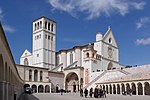
|
Perugia | 2000 | 990; i, ii, iii, iv, vi (cultural) | Assisi was the birthplace of Saint Francis, founder of the Franciscan order. The Basilica was built in the 13th century. It features paintings by Cimabue, Pietro Lorenzetti, Simone Martini, and Giotto, and has been used as a reference point for Italian and Western art.[41] |
| Late Baroque Towns of the Val di Noto (South-Eastern Sicily) | 
|
Catania, Ragusa, Syracuse | 2002 | 1024; i, ii, iv, v (cultural) | In 1693, a powerful earthquake hit Sicily, destroying several towns and cities. In the aftermath, the towns of Caltagirone, Militello Val di Catania, Catania, Modica, Noto, Palazzolo, Ragusa, and Scicli were rebuilt in line with the Baroque urban planning trends. They represent the pinnacle of late Baroque art in Europe.[42] |
| Sacri Monti of Piedmont and Lombardy | 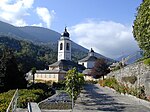
|
several sites | 2003 | 1068rev; ii, iv (cultural) | The phenomena of Sacri Monti (Sacred Mountains) began at the end of the 15th century with an aim of creating alternative pilgrimage and prayer sites due to inaccessibility of the Holy Land. The site comprises nine such complexes in Piedmont and Lombardy built in the late 16th and 17th centuries. They are rich in arts and are well integrated into the landscape. The Sacred Mount Calvary of Domodossola is pictured.[43] |
| Etruscan Necropolises of Cerveteri and Tarquinia | 
|
Viterbo, Metropolitan City of Rome Capital | 2004 | 1158; i, iii, iv (cultural) | Cerveteri and Tarquinia are two Etruscan cemeteries from the 9th to the 1st century BCE. Several tombs, that were designed as replicas of Etruscan houses, are decorated with outstanding wall paintings depicting scenes of daily life (the Tomb of the Leopards pictured).[44] |
| Syracuse and the Rocky Necropolis of Pantalica | 
|
Syracuse | 2005 | 1200; ii, iii, iv, vi (cultural) | Syracuse was founded in the 8th century BCE by the Corinthians and became one of the most important cities of Magna Graecia. An important monument from this period is the Doric Temple of Apollo. The Necropolis of Pantalica (pictured) contains more than 5,000 tombs, most dating from the 13th to the 7th centuries BCE, and remains of Byzantine era structures.[45] |
| Genoa: Le Strade Nuove and the system of the Palazzi dei Rolli | 
|
Metropolitan City of Genoa | 2006 | 1211; ii, iv (cultural) | This site comprises two urban developments in Genova from the 16th and 17th centuries, when the Republic of Genoa was at the peak of its power. Le Strade Nuove (New Streets) are a group of streets (including Via Giuseppe Garibaldi) built by the Genoese aristocracy. The Palazzi dei Rolli (Palaces of the Lists) are a group of Renaissance and Baroque palaces which were associated to a particular system of public lodging in private residences, whereby notable guests on State visit to the Republic were hosted in one of these palaces on behalf of the State. Palazzo Cattaneo Belimbau is pictured.[46] |
| Rhaetian Railway in the Albula / Bernina Landscapes* | 
|
Sondrio | 2008 | 1276; ii, iv (cultural) | The Albula and Bernina lines of the Rhaetian Railway are two historic railway lines that cross the Swiss Alps. They were built in the early 20th century, providing a rapid and easy route into many formerly isolated alpine settlements. Building the railroads required overcoming technical challenges with bridges, galleries, and tunnels. The site is shared with Switzerland. The train station in Tirano is pictured.[47] |
| Mantua and Sabbioneta | 
|
Mantua | 2008 | 1287; ii, iii (cultural) | These two towns represent two approaches of Renaissance period town planning. Mantua (pictured), originating in Roman times and preserving structures from the 11th century, was renovated in the 15th and 16th century. On the other hand, Sabbioneta was founded in the second half of the 16th century by Vespasiano I Gonzaga and built with a grid plan, according to the period's vision of an ideal city.[48] |
| Monte San Giorgio* | 
|
Varese | 2010 | 1090; viii (natural) | Monte San Giorgio, overlooking Lake Lugano, is regarded as the best fossil record of marine life from the Triassic Period (245–230 million years ago). In that period, the area was a tropical lagoon, flourishing with reptiles, fish, bivalves, ammonites, echinoderms, and crustaceans. Fossils of terrestrial animals are also preserved, as the lagoon was near the land. The part of the property in Switzerland was listed in 2003 and expanded to include the Italian part in 2010.[49] |
| Longobards in Italy. Places of the power (568-774 A.D.) | 
|
several sites | 2011 | 1318; ii, iii, vi (cultural) | This site comprises seven groups of monasteries, churches, and fortresses associated with the Longobards who ruled in Italy from the 6th to the 8th century. The arts and architecture reflect the synthesis of Roman, Christian, and Germanic influences. The monuments listed are located in Brescia, Cividale del Friuli (cathedral pictured), Castelseprio, Spoleto, Campello sul Clitunno, Benevento, and Monte Sant'Angelo. Its architecture marks a synthesis of various styles and the transition to the Middle Ages.[50] |
| Prehistoric Pile dwellings around the Alps* | 
|
several sites | 2011 | 1363; iv, v (cultural) | This transnational site (shared with Austria, France, Germany, Slovenia, and Switzerland) contains 111 small individual sites with the remains of prehistoric pile-dwelling (or stilt house) settlements in and around the Alps built from around 5000 to 500 BCE on the edges of lakes, rivers, or wetlands. They contain a wealth of information on life and trade in agrarian Neolithic and Bronze Age cultures in Alpine Europe. Nineteen sites are located in Italy, the reconstruction of a house at Ledro is pictured.[51] |
| Medici Villas and Gardens in Tuscany | 
|
several sites | 2013 | 175; ii, iv, vi (cultural) | This site comprises twelve villas and two gardens built under patronage of the Medici family in the 15th to 17th centuries in Tuscany. They represent a new type of aristocratic residences, in departure from military castles or rich farms. The villas and gardens were places of leisure, arts, and knowledge, and they were designed in line with the principles of Renaissance humanism. The Villa Medici in Fiesole is pictured.[52] |
| Mount Etna | 
|
Catania | 2013 | 1427; viii (natural) | Mount Etna is the most active stratovolcano in the world, as well as one of most studied volcanoes, with at least 2,700 years of documented history. It features several typical volcanic phenomena, such as cinder cones, lava flows, and lava caves. The mountain also supports a particular ecosystem with endemic flora and fauna.[53] |
| Arab-Norman Palermo and the Cathedral Churches of Cefalù and Monreale | 
|
Metropolitan City of Palermo | 2015 | 1487; ii, iv (cultural) | This site comprises nine buildings, constructed during the time of the Norman Kingdom of Sicily (1130-1194), in a style that incorporates features of Arab, Byzantine, and Western art. Two palaces, three churches, three cathedrals (Palermo Cathedral pictured), and the Admiral's Bridge are listed.[54] |
| Ancient and Primeval Beech Forests of the Carpathians and Other Regions of Europe* | 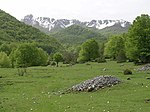
|
several sites | 2017 | 1133ter; ix (natural) | Primeval Beech Forests of the Carpathians are used to study the spread of the beech tree (Fagus sylvatica) in the Northern Hemisphere across a variety of environments and the environment in the forest. The site was first listed in 2007 in Slovakia and Ukraine. It was extended in 2011, 2017, and 2021 to include forests in a total of 18 countries. There are 13 forests listed in Italy, they were inscribed in 2017 and 2021. Val Fondillo is pictured.[55] |
| Venetian Works of Defence between the 16th and 17th centuries: Stato da Terra – Western Stato da Mar* | 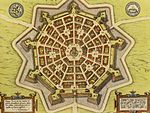
|
Bergamo, Udine, Verona | 2017 | 1533; iii, iv (cultural) | This property consists of six components of defence works in Italy, Croatia, and Montenegro, spanning more than 1,000 kilometres (620 mi) between the Lombard region of Italy and the eastern Adriatic Coast. The design of the fortifications (termed alla moderna) was marked by the introduction of gunpowder to warfare, which led to significant shifts in military techniques and architecture. Three sites are listed in Italy: the star fort of Palmanova (map pictured) and the fortifications of Bergamo and Peschiera del Garda.[56] |
| Ivrea, Industrial City of the 20th Century | 
|
Metropolitan City of Turin | 2018 | 1538bis; iv (cultural) | The Industrial City of Ivrea was founded in 1908 by Camillo Olivetti, head of the company Olivetti S.p.A. that produced typewriters, mechanical calculators, and office computers. The city was, mostly between 1930 and the 1960s, designed in line with the ideas of the political Community Movement. The complex includes industrial, residential, and public buildings, and expresses a modern vision of the relationship between industrial production and architecture. A minor boundary modification took place in 2021.[57] |
| The Great Spa Towns of Europe* | 
|
Pistoia | 2021 | 1613; ii, iii, iv, vi (cultural) | The Great Spa Towns of Europe comprises 11 spa towns in seven European countries where mineral waters were used for healing and therapeutic purposes before the development of industrial medication in the 19th century. The town of Montecatini Terme is listed in Italy.[58] |
| Padua's fourteenth-century fresco cycles | 
|
Padua | 2021 | 1623; ii (cultural) | The site comprises eight buildings, both religious and secular, in four clusters. They house fresco cycles that were painted between 1302 and 1397 by several prominent painters: Giotto, Guariento di Arpo, Giusto de' Menabuoi, Altichiero da Zevio, Jacopo d'Avanzi, and Jacopo da Verona. The frescos are innovative in view of in their way of depicting the allegorical narrative and use new way of perspective. The Scrovegni Chapel is pictored.[59] |
| The Porticoes of Bologna | 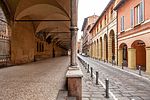
|
Bologna (BO), Emilia-Romagna |
52.18 (128.9); buffer zone 1,225.62 (3,028.6) | 1050; 2021; iv | |
| The Dolomites | 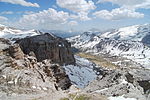
|
Several regions 46°36′47″N 12°9′47″E / 46.61306°N 12.16306°E |
141,903 (350,650); buffer zone 89,267 (220,580) | 1237; 2009; vii, viii | Mountain range in the Northern Italian Alps with 18 peaks above 3,000 (9,800), and some of the world's most beautiful mountain scenery including sheer rocky cliffs, vertical walls, long and narrow valleys.[60] |
| The Sassi and the Park of the Rupestrian Churches of Matera | 
|
Matera (MT), Basilicata 40°39′59″N 16°36′37″E / 40.66639°N 16.61028°E |
1,016 (2,510); buffer zone 4,365 (10,790) | 670; 1993; iii, iv, v | Most outstanding example of cave dwellings in the Mediterranean with parts of it dating to the Palaeolithic.[61] |
| The Trulli of Alberobello | 
|
Alberobello (BA), Apulia 40°46′57″N 17°14′13″E / 40.78250°N 17.23694°E |
11 (27) | 787; 1996; iii, iv, v | Small town with trulli, limestone huts in a prehistoric drywall technique, usually featuring conical, domed or pyramidal roofs of corbelled stone slabs.[62] |
| Val d'Orcia | 
|
Siena Province, Tuscany 43°4′N 11°33′E / 43.067°N 11.550°E |
61,188 (151,200); buffer zone 5,660 (14,000) | 1026; 2004; iv, vi | Part of the hinterland of Siena, the landscape was carefully redesigned during the Renaissance (14th and 15th century) to reflect an idealized model of government and to create a pleasing picture. It featured prominently in paintings of the time.[63] |
| Venice and its Lagoon | 
|
Venice Province, Veneto 45°26′3.5″N 12°20′20″E / 45.434306°N 12.33889°E |
70,176.4 (173,410) | 394; 1987; i, ii, iii, iv, v, vi | Founded in the 5th century and rising to prominence as a maritime power in the 10th century, Venice's unique location on 118 small islands harbors a large number of architectural masterpieces and major works by some of the greatest artists.[64] |
| Villa Adriana, Tivoli | 
|
Tivoli (RM), Lazio 41°56′39″N 12°46′19″E / 41.94417°N 12.77194°E |
80 (200); buffer zone 500 (1,200) | 907; 1999; i, ii, iii | Villa Adriana or "Hadrian's Villa" is a 2nd-century complex of classical buildings constructed by Emperor Hadrian combining architectural elements of Greece, Egypt and Rome.[65] |
| Villa d'Este, Tivoli | 
|
Tivoli (RM), Lazio 41°57′50″N 12°47′46.5″E / 41.96389°N 12.796250°E |
4.50 (11.1); buffer zone 7.00 (17.3) | 1025; 2001; i, ii, iii, iv, vi | Fine example of an Italian Renaissance palace and garden from the 16th century, the gardens of Villa d'Este are one of the Grandi Giardini Italiani and had a large influence on European garden design.[66] |
| Villa Romana del Casale | 
|
Piazza Armerina (EN), Sicily 37°21′58″N 14°20′3″E / 37.36611°N 14.33417°E |
8.92 (22.0); buffer zone 10 (25) | 832; 1997; i, ii, iii | One of the most luxurious Roman villas built in the early 4th century and decorated with mosaics of exceptional quality.[67] |
| Vineyard Landscape of Piedmont: Langhe-Roero and Monferrato | 
|
Alessandria Province, Asti Province and Cuneo Province, Piedmont 44°36′31″N 7°57′49″E / 44.60861°N 7.96361°E |
10,789 (26,660); buffer zone 76,249 (188,420) | 1390; 2014; iii, v | Winegrowing and processing area for Piemonte wine with a long history going back to at least the 5th century BC. The site includes the Castle of Grinzane Cavour.[68] |
| The Prosecco Hills of Conegliano and Valdobbiadene. ("Le Colline del Prosecco di Conegliano e Valdobbiadene") | 
|
Treviso Province, Veneto 45°53′12″N 12°17′50″E / 45.88667°N 12.29722°E |
20,334.02 (50,246.5); buffer zone 43,988.2 (108,697) | 1571; 2019; v | Winegrowing landscape characterized by ciclioni hills, forests, small villages and farmland, for centuries shaped and adapted by man.[69] |
Tentative list[]
In addition to the sites inscribed on the World Heritage List, member states can maintain a list of tentative sites that they may consider for nomination. Nominations for the World Heritage List are only accepted if the site has previously been listed on the tentative list.[70] As of 2021, Italy recorded 31 tentative sites.[3]
| Year | Name | Region | Image |
|---|---|---|---|
| 2006 | Archipelago of La Maddalena and Islands of Bocche di Bonifacio | Sardinia | 
|
| 2006 | Bradyseism in the Flegrea Area | Campania | 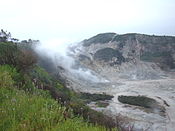
|
| 2006 | Cascata delle Marmore and Valnerina: Monastic sites and ancient hydro-geological reclamation works | Umbria and Marche | 
|
| 2006 | Cattolica Monastery in Stilo and Basilian-Byzantine complexes | Calabria | 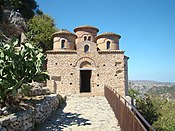
|
| 2006 | Citadel of Alessandria | Piedmont | 
|
| 2006 | Hanbury botanical gardens | Liguria | 
|
| 2006 | Island of Asinara | Sardinia | 
|
| 2006 | Carsic caves in prehistoric Apulia | Apulia | 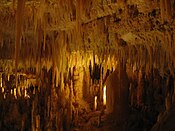
|
| 2006 | Lake Maggiore and Lake D'Orta lakelands | Lombardy and Piedmont | 
|
| 2006 | Mothia Island and Lilibeo: The Phoenician-Punic Civilization in Italy | Sicily | 
|
| 2006 | Orvieto | Umbria | 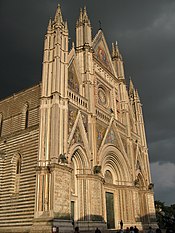
|
| 2006 | Pelagos: The Cetacean Sanctuary | Sardinia, Liguria and Tuscany | 
|
| 2006 | Salento and the "Barocco Leccese" | Apulia | 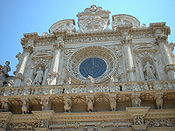
|
| 2006 | Sulcis and Iglesiente | Sardinia | 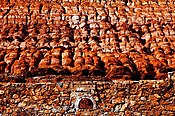
|
| 2006 | The Aniene valley and Villa Gregoriana in Tivoli | Lazio | 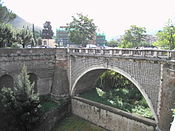
|
| 2006 | The Marble Basin of Carrara | Tuscany | 
|
| 2006 | The Murge of Altamura | Apulia | 
|
| 2006 | The Transhumance: The "Royal Shepherd's Track" (Il Cammino Reale) | Abruzzo, Apulia, Campania and Molise | 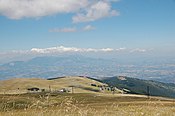
|
| 2006 | Via Appia "Regina Viarum" | Apulia, Basilicata, Campania and Lazio | 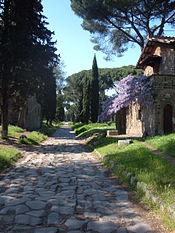
|
| 2006 | Villas of the Papal Nobility | Lazio | 
|
| 2006 | Volterra: Historical City and Cultural Landscape | Tuscany | 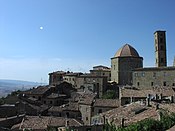
|
| 2008 | Border area of Mont-Blanc (together with France and Switzerland) | Valle d'Aosta | 
|
| 2016 | The cultural landscape of the Benedictine settlements in medieval Italy | Several | 
|
| 2017 | The Cultural Landscape of Civita di Bagnoregio | Lazio | 
|
| 2017 | Les Alpes de la Méditerranée (Italy) -Ligurian Alps and Maritime Alps | Liguria and Piedmont | 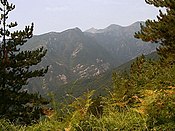 |
| 2018 | Evaporite karst and caves of Emilia Romagna Region | Emilia Romagna | 
|
| 2019 | Via Francigena in Italy | Valle d'Aosta, Piedmont, Lombardy, Emilia Romagna, Ligura, Tuscany and Lazio | 
|
| 2021 | Art and Architecture in the Prehistory of Sardinia: the domus de janas | Sardinia | 
|
| 2021 | Eocene Marine Biodiversity of the Alpone Valley | Veneto | 
|
| 2021 | Historical theatres of the Marche Region | Marche | 
|
| 2021 | Nuragic monuments of Sardinia | Sardinia | 
|
Notes[]
References[]
- ^ "The World Heritage Convention". UNESCO World Heritage Centre. Archived from the original on 27 August 2016. Retrieved 7 July 2019.
- ^ "Convention Concerning the Protection of the World Cultural and Natural Heritage". UNESCO World Heritage Centre. Archived from the original on 1 February 2021. Retrieved 3 February 2021.
- ^ a b c d e "Italy". UNESCO World Heritage Centre. Archived from the original on December 1, 2021. Retrieved April 9, 2019.
- ^ Centre, UNESCO World Heritage. "UNESCO World Heritage Centre – World Heritage List". whc.unesco.org. Archived from the original on 2020-11-02. Retrieved 2021-12-20.
- ^ "Report of the Rapporteur". UNESCO World Heritage Centre. November 30, 1979. Archived from the original on July 5, 2020. Retrieved July 12, 2014.
- ^ Centre, UNESCO World Heritage. "Italy – UNESCO World Heritage Centre". whc.unesco.org. Archived from the original on 2021-12-01. Retrieved 2019-12-26.
- ^ "UNESCO World Heritage Centre – The Criteria for Selection". UNESCO World Heritage Centre. Archived from the original on 12 June 2016. Retrieved 17 August 2018.
- ^ "Rock Drawings in Valcamonica". UNESCO World Heritage Centre. Archived from the original on 3 July 2010. Retrieved 26 June 2010.
- ^ Emmanuel Anati. "The Way of Life Recorded in the Rock Art of Valcamonica" (PDF). Tanum Museum of Rock Carvings. Retrieved 24 December 2021.
- ^ "Historic Centre of Rome, the Properties of the Holy See in that City Enjoying Extraterritorial Rights and San Paolo Fuori le Mura". UNESCO World Heritage Centre. Archived from the original on 24 February 2011. Retrieved 26 June 2010.
- ^ "Church and Dominican Convent of Santa Maria delle Grazie with "The Last Supper" by Leonardo da Vinci". UNESCO World Heritage Centre. Archived from the original on 4 July 2010. Retrieved 26 June 2010.
- ^ "Historic Centre of Florence". UNESCO World Heritage Centre. Archived from the original on 3 July 2010. Retrieved 26 June 2010.
- ^ "Piazza del Duomo, Pisa". UNESCO World Heritage Centre. Archived from the original on 2 September 2016. Retrieved 26 June 2010.
- ^ "Decision – 31COM 8B.61 – Nomination of natural, mixed and cultural properties to the world heritage list – Piazza del Duomo, Pisa". UNESCO World Heritage Centre. Archived from the original on 8 November 2011. Retrieved 26 June 2010.
- ^ "Historic Centre of San Gimignano". UNESCO World Heritage Centre. Archived from the original on 4 July 2010. Retrieved 26 June 2010.
- ^ "City of Vicenza and the Palladian Villas of the Veneto". UNESCO World Heritage Centre. Archived from the original on 3 July 2010. Retrieved 26 June 2010.
- ^ "Decision – 20COM VIII.C – Extension and Change of Name: The City of Vicenza and the Palladian Villas of the Veneto (Italy)". UNESCO World Heritage Centre. Archived from the original on 27 February 2013. Retrieved 26 June 2010.
- ^ "Historic Centre of Siena". UNESCO World Heritage Centre. Archived from the original on 3 July 2010. Retrieved 26 June 2010.
- ^ "Historic Centre of Naples". UNESCO World Heritage Centre. Archived from the original on 19 May 2021. Retrieved 26 June 2010.
- ^ "Crespi d'Adda". UNESCO World Heritage Centre. Archived from the original on 4 July 2010. Retrieved 26 June 2010.
- ^ "Ferrara, City of the Renaissance, and its Po Delta". UNESCO World Heritage Centre. Archived from the original on 4 July 2010. Retrieved 26 June 2010.
- ^ "Decision – 23COM VIII.C.2 – Extension: Ferrara, City of the Renaissance and its Po Delta (extension of Ferrara, city of the Renaissance) (Italy)". UNESCO World Heritage Centre. Archived from the original on 2 March 2013. Retrieved 26 June 2010.
- ^ "Castel del Monte". UNESCO World Heritage Centre. Archived from the original on 3 July 2010. Retrieved 26 June 2010.
- ^ "Early Christian Monuments of Ravenna". UNESCO World Heritage Centre. Archived from the original on 3 July 2010. Retrieved 26 June 2010.
- ^ "Historic Centre of the City of Pienza". UNESCO World Heritage Centre. Archived from the original on 4 July 2010. Retrieved 26 June 2010.
- ^ "18th-Century Royal Palace at Caserta with the Park, the Aqueduct of Vanvitelli, and the San Leucio Complex". UNESCO World Heritage Centre. Archived from the original on 4 July 2010. Retrieved 26 June 2010.
- ^ "Residences of the Royal House of Savoy". UNESCO World Heritage Centre. Archived from the original on 4 July 2010. Retrieved 26 June 2010.
- ^ "Decision – 34COM 8B.58 – Cultural Properties – Examination of minor boundary modifications – Residences of the Royal House of Savoy (Italy)". UNESCO World Heritage Centre. Archived from the original on 8 November 2011. Retrieved 26 June 2010.
- ^ "Botanical Garden (Orto Botanico), Padua". UNESCO World Heritage Centre. Archived from the original on 4 July 2010. Retrieved 26 June 2010.
- ^ "Portovenere, Cinque Terre, and the Islands (Palmaria, Tino and Tinetto)". UNESCO World Heritage Centre. Archived from the original on 4 July 2010. Retrieved 26 June 2010.
- ^ "Cathedral, Torre Civica and Piazza Grande, Modena". UNESCO World Heritage Centre. Archived from the original on 27 December 2009. Retrieved 26 June 2010.
- ^ "Costiera Amalfitana". UNESCO World Heritage Centre. Archived from the original on 4 July 2010. Retrieved 26 June 2010.
- ^ "Archaeological Area of Agrigento". UNESCO World Heritage Centre. Archived from the original on 7 August 2010. Retrieved 26 June 2010.
- ^ "Archaeological Areas of Pompei, Herculaneum and Torre Annunziata". UNESCO World Heritage Centre. Archived from the original on 4 July 2010. Retrieved 26 June 2010.
- ^ "Su Nuraxi di Barumini". UNESCO World Heritage Centre. Archived from the original on 3 July 2010. Retrieved 26 June 2010.
- ^ "Archaeological Area and the Patriarchal Basilica of Aquileia". UNESCO World Heritage Centre. Archived from the original on 16 December 2005. Retrieved 26 June 2010.
- ^ "Historic Centre of Urbino". UNESCO World Heritage Centre. Archived from the original on 19 January 2013. Retrieved 26 June 2010.
- ^ "Cilento and Vallo di Diano National Park with the Archeological sites of Paestum and Velia, and the Certosa di Padula". UNESCO World Heritage Centre. Archived from the original on 3 July 2010. Retrieved 26 June 2010.
- ^ "City of Verona". UNESCO World Heritage Centre. Archived from the original on 3 July 2010. Retrieved 26 June 2010.
- ^ "Isole Eolie (Aeolian Islands)". UNESCO World Heritage Centre. Archived from the original on 3 July 2010. Retrieved 26 June 2010.
- ^ "Assisi, the Basilica of San Francesco and Other Franciscan Sites". UNESCO World Heritage Centre. Archived from the original on 3 July 2010. Retrieved 26 June 2010.
- ^ "Late Baroque Towns of the Val di Noto (South-Eastern Sicily)". UNESCO World Heritage Centre. Archived from the original on 3 July 2010. Retrieved 26 June 2010.
- ^ "Sacri Monti of Piedmont and Lombardy". UNESCO World Heritage Centre. Archived from the original on 2 April 2011. Retrieved 26 June 2010.
- ^ "Etruscan Necropolises of Cerveteri and Tarquinia". UNESCO World Heritage Centre. Archived from the original on 3 July 2010. Retrieved 26 June 2010.
- ^ "Syracuse and the Rocky Necropolis of Pantalica". UNESCO World Heritage Centre. Archived from the original on 4 July 2010. Retrieved 26 June 2010.
- ^ "Genoa: Le Strade Nuove and the system of the Palazzi dei Rolli". UNESCO World Heritage Centre. Archived from the original on 21 June 2010. Retrieved 26 June 2010.
- ^ "Rhaetian Railway in the Albula / Bernina Landscapes". UNESCO World Heritage Centre. Archived from the original on 2 March 2012. Retrieved 10 December 2020.
- ^ "Mantua and Sabbioneta". UNESCO World Heritage Centre. Archived from the original on 28 October 2010. Retrieved 26 June 2010.
- ^ "Monte San Giorgio". UNESCO World Heritage Centre. Archived from the original on 6 February 2012. Retrieved 10 December 2020.
- ^ "Longobards in Italy. Places of the power (568–774 A.D.)". UNESCO World Heritage Centre. Archived from the original on 30 June 2011. Retrieved 26 June 2010.
- ^ "Prehistoric Pile Dwellings Around the Alps". UNESCO World Heritage Centre. Archived from the original on 3 October 2020. Retrieved 10 December 2020.
- ^ "Medici Villas and Gardens in Tuscany". UNESCO World Heritage Centre. Archived from the original on 20 August 2013. Retrieved 4 August 2013.
- ^ "Mount Etna". UNESCO World Heritage Centre. Archived from the original on 6 August 2013. Retrieved 4 August 2013.
- ^ "Arab-Norman Palermo and the Cathedral Churches of Cefalú and Monreale". UNESCO World Heritage Centre. Archived from the original on 17 December 2021. Retrieved 18 December 2021.
- ^ "Ancient and Primeval Beech Forests of the Carpathians and Other Regions of Europe". UNESCO World Heritage Centre. Archived from the original on 2 March 2012. Retrieved 7 September 2017.
- ^ "Venetian Works of Defence between the 16th and 17th Centuries: Stato da Terra – Western Stato da Mar". UNESCO World Heritage Centre. Archived from the original on 6 September 2017. Retrieved 30 August 2017.
- ^ "Ivrea, industrial city of the 20th century". UNESCO. Archived from the original on 2021-11-27. Retrieved 2019-12-26.
 This article incorporates text from this source, which is in the public domain.
This article incorporates text from this source, which is in the public domain.
- ^ "The Great Spa Towns of Europe". UNESCO World Heritage Centre. Archived from the original on 28 July 2021. Retrieved 1 August 2021.
- ^ "Padua's fourteenth-century fresco cycles". UNESCO World Heritage Centre. Retrieved 27 December 2021.
- ^ "The Dolomites". UNESCO World Heritage Centre. Archived from the original on 4 July 2010. Retrieved 26 June 2010.
- ^ "The Sassi and the Park of the Rupestrian Churches of Matera". UNESCO World Heritage Centre. Archived from the original on 4 July 2010. Retrieved 26 June 2010.
- ^ "The Trulli of Alberobello". UNESCO World Heritage Centre. Archived from the original on 3 July 2010. Retrieved 26 June 2010.
- ^ "Val d'Orcia". UNESCO World Heritage Centre. Archived from the original on 4 July 2010. Retrieved 26 June 2010.
- ^ "Venice and its Lagoon". UNESCO World Heritage Centre. Archived from the original on 3 July 2010. Retrieved 26 June 2010.
- ^ "Villa Adriana (Tivoli)". UNESCO World Heritage Centre. Archived from the original on 20 December 2021. Retrieved 26 June 2010.
- ^ "Villa d'Este, Tivoli". UNESCO World Heritage Centre. Archived from the original on 20 December 2021. Retrieved 26 June 2010.
- ^ "Villa Romana del Casale". UNESCO World Heritage Centre. Archived from the original on 26 August 2010. Retrieved 26 June 2010.
- ^ "Vineyard Landscape of Piedmont: Langhe-Roero and Monferrato". UNESCO World Heritage Centre. Archived from the original on 28 July 2014. Retrieved 29 July 2014.
- ^ "The Prosecco Hills of Conegliano and Valdobbiadene". UNESCO. Archived from the original on 2020-10-07. Retrieved 2019-09-23.
- ^ "Tentative Lists". UNESCO. Archived from the original on July 29, 2020. Retrieved July 12, 2014.
- World Heritage Sites in Italy
- Lists of World Heritage Sites
- Lists of tourist attractions in Italy

